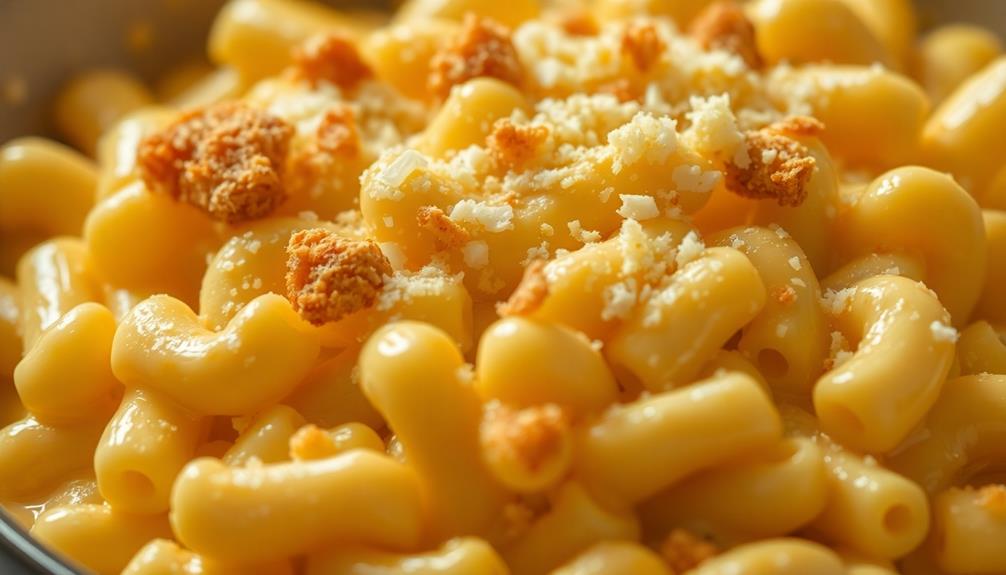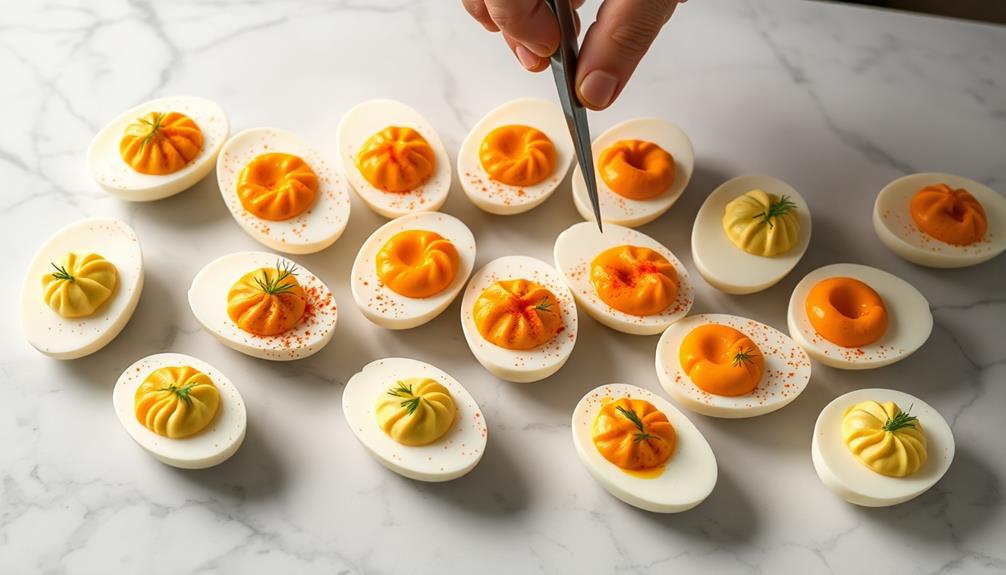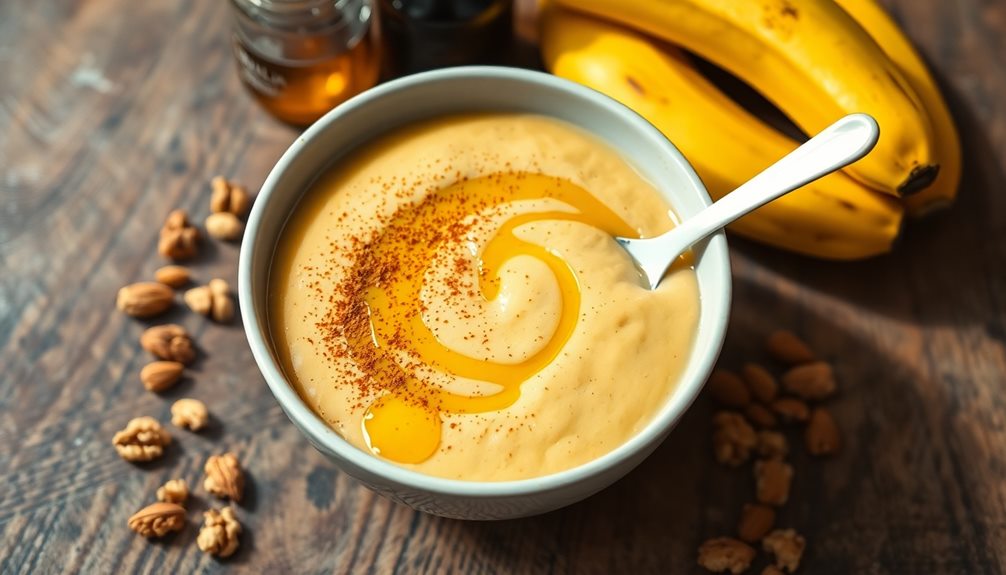Macaroni and cheese is a delightful dish that's been delighting taste buds for centuries! Its origins trace back to 13th century Italy, and it later gained popularity in England during the 1700s. Thomas Jefferson even introduced the dish to America after his travels in Italy. Today, it's a beloved comfort food that comes in endless variations – from classic baked versions to stovetop creations. You can customize it with high-quality cheddar and Parmesan cheeses, breadcrumbs, or even mix it with other ingredients. And wait until you learn about its fascinating cultural significance!
Key Takeaways
- Macaroni and cheese is a classic comfort food dish with origins dating back to the 13th century in Italy and gained popularity in England during the 1700s.
- The core ingredients include elbow macaroni, cheddar cheese, milk or cream, butter, and optional breadcrumbs for a baked or stovetop preparation.
- The dish is known for its versatility, allowing endless variations and customizations to suit personal preferences and dietary needs.
- Macaroni and cheese is recognized as a significant part of American cuisine, often associated with nostalgia and served at family gatherings.
- Preparation techniques involve boiling the pasta, creating a creamy cheese sauce, and baking the dish for a golden-brown, melted cheese topping.
History
Tracing the origins of macaroni and cheese, the dish has long been a staple in many cultures, with evidence of its existence dating back to the 13th century.
Its earliest known recipe was recorded in the Italian cookbook Liber de Coquina, which described a dish made with sheets of pasta and cheese. This early version of macaroni and cheese evolved over the centuries, with different regions and cultures putting their own spin on the classic comfort food.
In the 1700s, the dish gained popularity in England, where it was served as a specialty at the royal court.
Thomas Jefferson, the third president of the United States, is credited with introducing macaroni and cheese to America after he discovered it during his travels in Italy.
Recipe
Macaroni and cheese is a classic comfort food that has been enjoyed by generations. This beloved dish isn't only delicious but also incredibly versatile, allowing for endless variations and customizations.
At its core, macaroni and cheese is a simple combination of pasta, cheese, and a creamy sauce. However, the true art lies in the perfect execution of this seemingly straightforward recipe. From the selection of the cheese to the texture of the pasta, every element contributes to the overall harmony of the dish.
Ingredients:
- 8 ounces elbow macaroni
- 2 tablespoons unsalted butter
- 2 tablespoons all-purpose flour
- 2 cups milk
- 2 cups shredded cheddar cheese
- 1/2 cup grated Parmesan cheese
- 1/2 teaspoon salt
- 1/4 teaspoon black pepper
Directions:
In a large pot, cook the macaroni according to the package instructions until al dente. Drain and set aside.
In a saucepan, melt the butter over medium heat. Whisk in the flour and cook for 2 minutes, stirring constantly. Gradually pour in the milk, whisking continuously to prevent lumps. Bring the mixture to a simmer and cook until thickened, about 5 minutes.
Remove the saucepan from heat and stir in the cheddar cheese, Parmesan cheese, salt, and pepper until the cheese has melted and the sauce is smooth.
For the best results, use a combination of high-quality cheddar and Parmesan cheeses. The cheddar provides the classic flavor, while the Parmesan adds a savory depth. Together, these two cheeses create a deliciously rich and creamy texture that is perfect for gourmet grilled cheese recipes. The sharpness of the cheddar and the nutty, salty taste of the Parmesan complement each other perfectly, making for a truly decadent and mouthwatering grilled cheese sandwich. Whether you prefer a simple classic recipe or enjoy experimenting with unique combinations of ingredients, using high-quality cheddar and Parmesan cheeses is the key to taking your gourmet grilled cheese recipes to the next level.
Additionally, be mindful of the cooking time for the pasta to ensure it remains firm and doesn't become overcooked. Serve the macaroni and cheese immediately, garnished with a sprinkle of fresh parsley or a crispy breadcrumb topping for added texture.
Cooking Steps
Preheat your oven to 375°F, then boil the pasta according to the package directions.
Once drained, add the cheese and bake it in the oven for 20 minutes.
Serve this delightful dish immediately and enjoy!
Step 1. Preheat Oven to 375°F

To get started, preheat your oven to 375°F. This temperature is perfect for baking the macaroni and cheese to perfection. It'll ensure the cheese melts beautifully and the breadcrumb topping gets nice and crispy.
Once your oven is preheated, you'll want to grab a baking dish. A 9×13 inch dish works great for this recipe. Grease the dish with a bit of butter or non-stick cooking spray so the macaroni doesn't stick.
With the oven ready and the baking dish prepared, you're all set to start assembling the mac and cheese. The next step is to cook the pasta according to the package instructions.
Drain it well and then add the other ingredients to create that classic creamy, cheesy sauce. After that, you'll transfer the mac and cheese to the prepared baking dish, top it with breadcrumbs, and pop it in the oven.
In about 20-25 minutes, you'll have a piping hot, bubbly dish of homemade macaroni and cheese!
Step 2. Boil Pasta According to Package Directions

Next, cook the pasta according to the package directions. Grab a large pot and fill it with plenty of water. Bring the water to a rapid boil over high heat.
Once the water is boiling, carefully pour in the macaroni noodles. Stir the pasta gently to prevent it from sticking together. Cook the noodles for the amount of time specified on the package, usually between 7 to 10 minutes. Be sure to set a timer so you don't overcook the pasta.
As the pasta cooks, give it an occasional stir. You'll know it's done when the noodles are tender yet still have a slight bite to them.
Drain the cooked pasta in a colander, making sure to remove all the water. Gently shake the colander to help the pasta drain completely.
Now the pasta is ready to be combined with the creamy cheese sauce. Get ready for a cheesy, comforting masterpiece!
Step 3. Drain Pasta, Then Add Cheese

Once the pasta has finished cooking, it's time to drain it thoroughly. Carefully pour the pasta into a colander in the sink, allowing all the hot water to drain away. You don't want any excess liquid to remain, as that could water down the cheese sauce.
With the pasta drained, it's now time to add the cheese. Grab your block of cheddar cheese and start shredding it using a box grater. The finer you grate the cheese, the better it will melt into the pasta.
Pour the shredded cheese directly into the drained pasta and stir everything together. As the warm pasta melts the cheese, you'll see a creamy, cheesy sauce start to form.
Keep stirring until all the cheese is fully incorporated and the pasta is evenly coated. The key is to work quickly, so the heat of the pasta helps the cheese melt smoothly. With the cheese sauce ready, your macaroni and cheese is almost complete!
Step 4. Bake in Oven for 20 Minutes
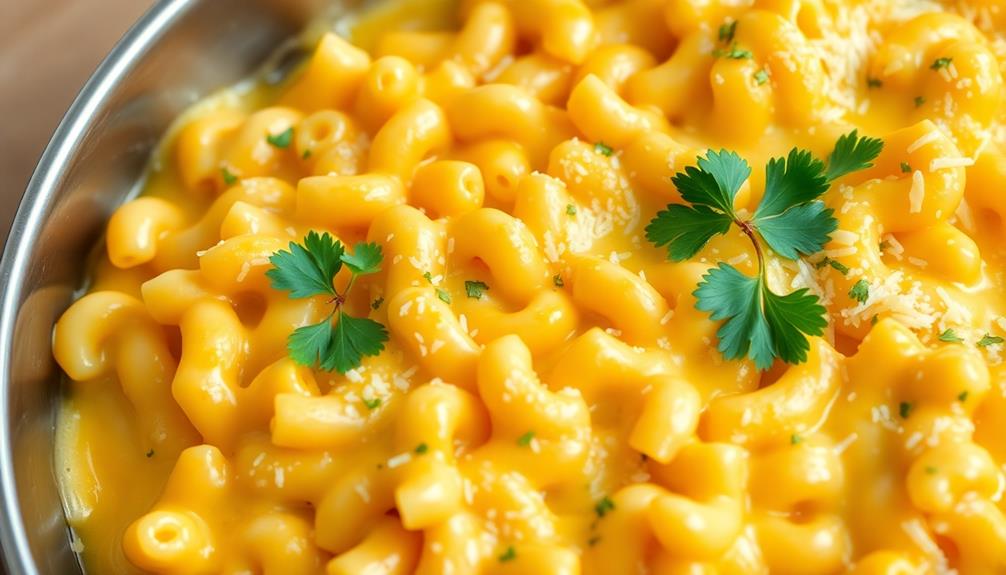
Preheat your oven to 350°F (175°C).
Once your pasta is drained, it's time to bake your macaroni and cheese. Grab an oven-safe dish and transfer the cheesy pasta into it. Spread it out evenly, ensuring all the noodles are covered in that creamy, melty goodness.
Next, you'll want to top your mac and cheese. Sprinkle a layer of shredded cheese over the top. This will create a crispy, golden-brown crust as it bakes. You can use your favorite cheese, or mix and match for different flavors.
Pop the dish into the preheated oven and let it bake for 20 minutes. The cheese will melt and the edges will start to brown, signaling that it's ready.
Be careful when you remove the hot dish from the oven. Allow it to cool for a few minutes before serving.
Mmm, can you already smell that cheesy, comforting aroma? Get ready to enjoy a piping hot, perfectly baked macaroni and cheese!
Step 5. Serve and Enjoy Immediately
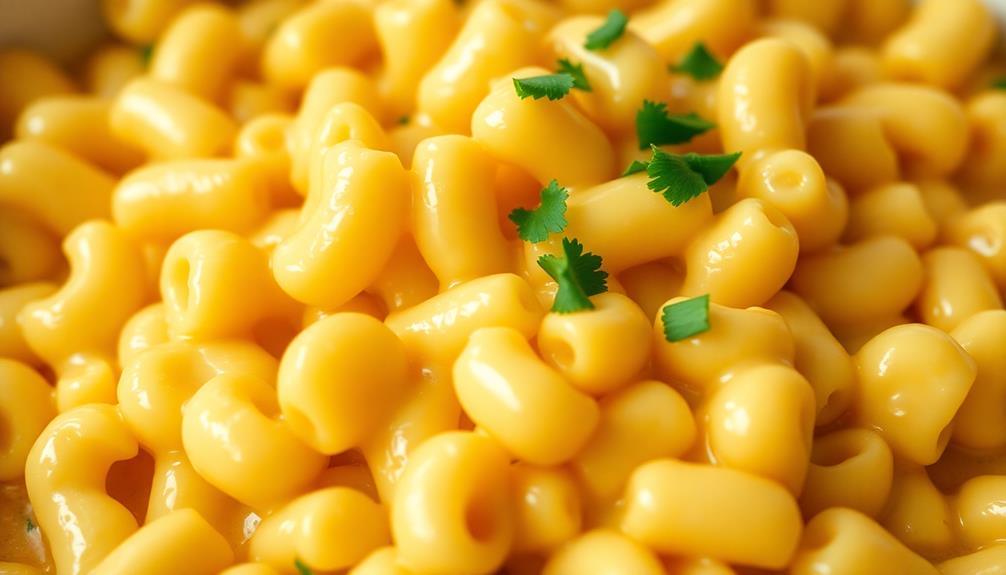
After the mac and cheese has finished baking, it's time to serve and enjoy your creation immediately.
Grab your oven mitts and carefully remove the piping hot dish from the oven. The cheesy, golden-brown top should be bubbly and irresistible. Mmm, can you smell that delightful aroma?
Using a serving spoon, scoop out generous helpings of the gooey, melted cheese and macaroni onto plates or bowls.
Be sure to get a little bit of that crispy, baked topping in each serving. It's the perfect contrast to the smooth, creamy sauce.
Don't wait a moment longer! Dive right in while the mac and cheese is still warm.
The first bite will be heavenly – the pasta perfectly cooked, the cheese oozing with flavor.
Savor each delicious mouthful, and don't be afraid to go back for seconds.
This homemade mac and cheese is simply too good to resist. Enjoy!
Final Thoughts
Macaroni and cheese is a classic comfort food that can be enjoyed in countless ways. Whether you prefer it baked, stovetop, or even with fun mix-ins, the possibilities are endless.
As you've seen, this beloved dish can be tailored to suit any taste or occasion. From creamy and indulgent to light and healthy, the versatility of mac and cheese is truly unparalleled.
As you savor that final bite, remember that the joy of this dish extends far beyond the plate. Sharing a warm, comforting meal with loved ones can nourish both the body and the soul.
Frequently Asked Questions
Can I Use Different Types of Cheese in Macaroni and Cheese?
You can definitely use different types of cheese in your dish. Experiment with a blend of cheeses like cheddar, Gruyère, Parmesan, or even a touch of cream cheese for a creamy, flavorful macaroni and cheese.
How Can I Make My Macaroni and Cheese Creamier?
To make your dish creamier, you can use a mix of different cheeses, add a splash of milk or cream, and don't forget to stir the sauce continuously until it reaches your desired consistency.
Is It Possible to Make Macaroni and Cheese Healthier?
Yes, you can make your dish healthier. Try using reduced-fat cheese, whole-grain pasta, and adding extra vegetables like broccoli or spinach. You can also experiment with different seasonings to enhance the flavor without relying solely on cheese.
Can I Freeze Leftover Macaroni and Cheese?
Yes, you can freeze leftover macaroni and cheese. Just store it in an airtight container and it'll keep for up to 3 months. When you're ready to enjoy it, simply thaw it in the fridge overnight and reheat it on the stovetop.
How Do I Prevent My Macaroni and Cheese From Becoming Dry?
To prevent your dish from becoming dry, add a bit of milk or cream when reheating and stir frequently. This will help keep the cheese sauce smooth and creamy, ensuring your leftovers stay moist and delicious.
Conclusion
You've got to try this classic comfort food! Macaroni and cheese is the ultimate tasty, creamy dish that'll have you going back for seconds. The rich, gooey cheese sauce perfectly coats the tender noodles, creating a heavenly combo that's sure to satisfy. Whether you're a kid or just a kid at heart, this easy-to-make meal is a crowd-pleaser that'll bring a smile to your face. So what are you waiting for? Dig in and enjoy every bite!
